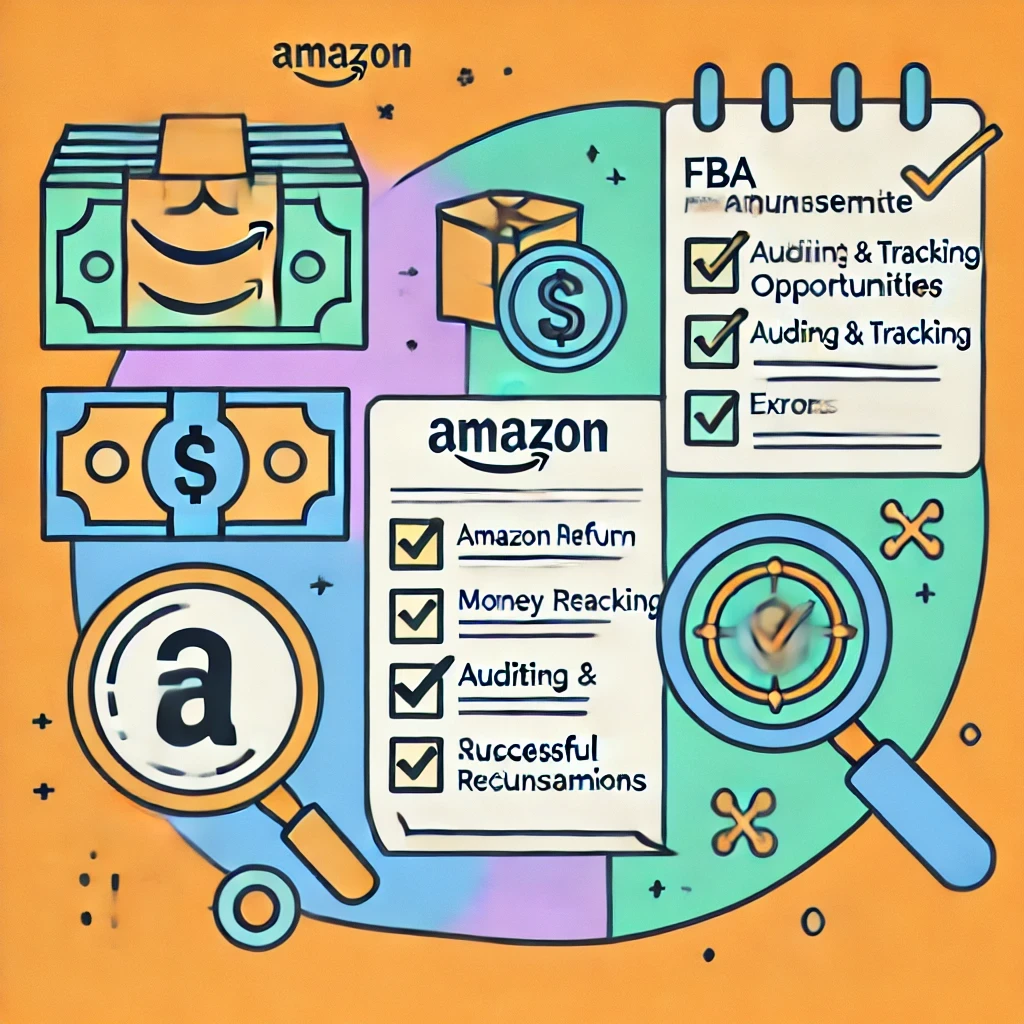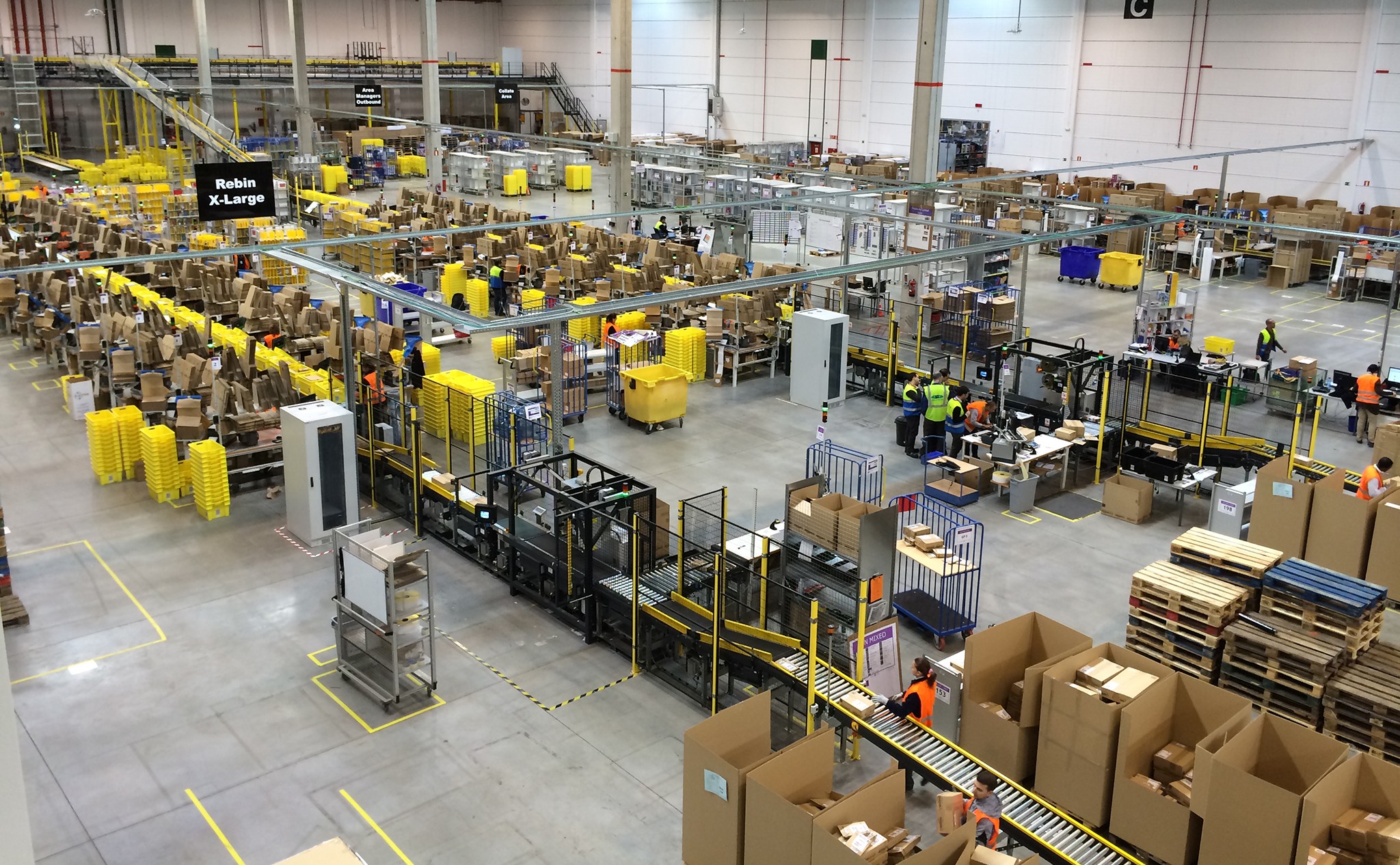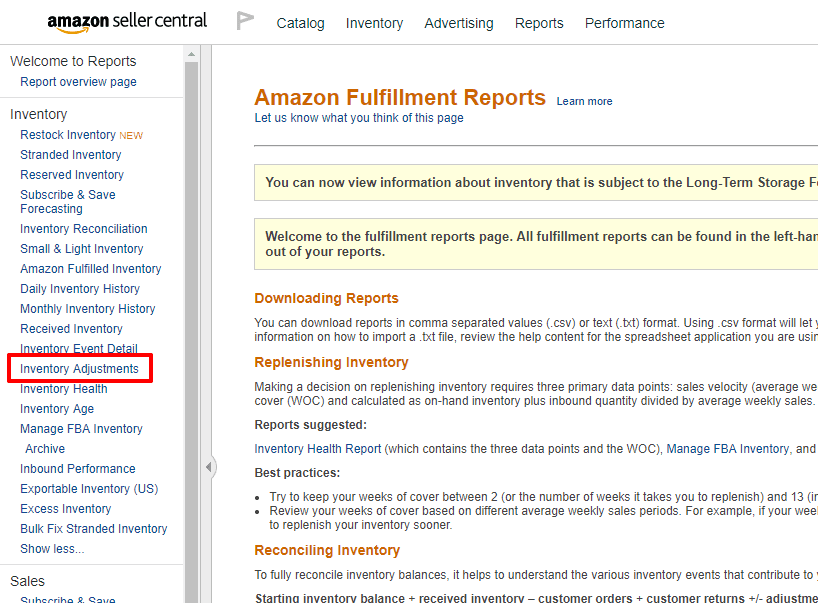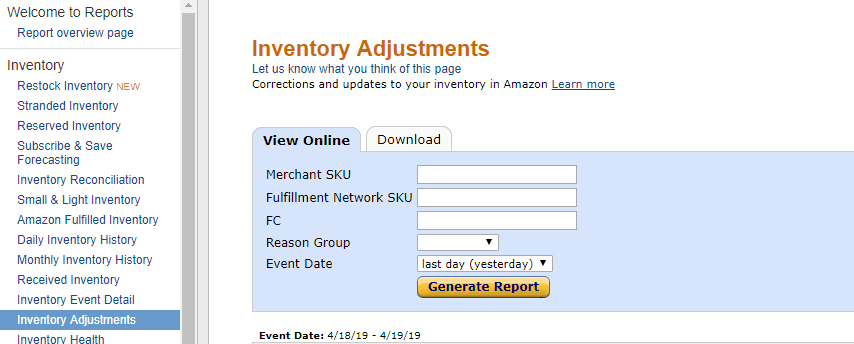Back to Page
Amazon Reimbursement
Claim Your Money Back with Most Common Amazon FBA Reimbursement Opportunities
Claim Your Money Back with Most Common Amazon FBA Reimbursement Opportunities


Back to Page
Amazon Reimbursement
Claim Your Money Back with Most Common Amazon FBA Reimbursement Opportunities

FBA is a huge operation and there are hundreds of robots, machines and humans working to pick, pack, and ship seller’s products. As mighty it may be, mistakes happen and they are more frequent than you think. But you should not pay for Amazon’s mistakes. When Amazon drops, break, misplaces or damages your product they are liable to pay you for that. Amazon picks some of them, but some are slipped through the cracks.
Amazon might owe you money and you might not even know about it!

That is why we have listed out some common situations under which Amazon owes you money.
Three main circumstances under which Amazon will refund a seller:
Reason 1: Customer Returns Not Returned To Inventory
There are times when your product does not live up to the customer’s expectations. If your after-sale policies include a return option, the buyer can send back the item and is entitled to achieve a full refund if he is not completely satisfied. This looks fairly straightforward – the buyer sends the item back and gets their money back. Most of the time, the product is in good condition and the seller can re-sell it.

However, unfortunately, Amazon’s computer system may make the refund, and mark the item as ‘returned to inventory’ whereas, in reality, the item was never received. When you are working on tight margins or selling a very high-priced product (for example: jewelry or antique), then you cannot afford to lose inventory. Plus checking on these issues continuously is not easy because refunds can also happen even after months of sale.
Reason 2: Damaged Or Lost Inventory
The second most common cause where the seller is eligible for reimbursement is for an inventory that has been damaged or lost because of Amazon’s mistakes. Goods once sent to Amazon Fulfillment Centers are the responsibility of Amazon so any loss or damage done to them should be paid by Amazon.
This includes the following:
Product lost or damaged within a fulfillment center
Product lost or damaged while in transit to a fulfillment center from seller’s warehouse
Product lost or damaged while in transit from a fulfillment center to customers
Product that has been missing from a fulfillment center for more than a month

As Amazon is the largest online retail operation in the world, loss and damage are inevitable. Most of the time, Amazon will notify, but sometimes it won't. So it is ultimately the seller’s responsibility to keep track of their inventory as well as spot and report if there are any inconsistencies.
Reason 3: Customer Never Returns An Item
Handling customer returns is an integral yet messy process for any ecommerce business. Luckily Amazon sellers can choose FBA to handle the returns and refunds. Sellers in Shopify stores need to process customer returns on their own.

As mentioned above, most of the customers DO return the product after initiating the product returns, but of course, there are times when the process doesn’t move this smoothly. Because of the forgetfulness or dishonesty of buyers, the return process is completed, but the product is not sent back to the Amazon warehouse. According to Amazon’s “customer-centric” approach, the customer will be given a refund even before he returns the product, which means that you gave a refund for a product that you never got back. In this instance, you have the right to request reimbursement from Amazon.
Apart from these, here are some other errors where you can claim Amazon Reimbursements:
In some returns, Amazon charges a restocking fee (20% of the product cost) from the customers. If the item is successfully back to Amazon’s warehouse, the seller has the right to that fee. If not received seller should contact Amazon and claim back the amount.
Amazon charges a commission on various categories. If seller notices that they are overcharged, they can ask for a reimbursement. For example, they are paying 15% instead of 8% commission.
For some reason, the seller might create a removal order. If the product is not received back by the seller, then Amazon is ready to reimburse the refunds.
This is a tricky one. When a customer complains about too high a shipping cost, it is not a problem for the FBA seller. Because this is Amazon’s error, they should be the ones fixing it.
Some customers receive more than the refund amount. Lucky aren’t they? However, the cost of this additional refund is supposed to be paid by Amazon, not the seller. They can claim reimbursement if they notice this.
Even though Amazon’s policy is to reimburse the sellers in the above-mentioned circumstances; sellers might have a hard time getting money back from Amazon, mostly because of poor customer service and some logic less Amazon rules. But there are some tools which can help you to make the process a little smoother:
Refunds Manager: http://refundsmanager.com/
AMZRefund: https://www.amzrefund.com/
FBA Auditor: https://www.fbaauditor.com/
AMZ Suite: https://amzsuite.com/
Helium10: https://www.helium10.com/
Yes, these tools can make the process simple, but they charge a robust amount for the service, AND many things are supposed to be done manually. Plus sometimes Amazon might suspend the accounts that use automated refund services because of the high amount of incorrect requests. So it’s always better to know all about it yourself, just in case sometimes you need it.
PPC Entourage is coming up with a brand new tool "Entourage Margins" soon! Unfortunately, a lot of Amazon sellers have no true knowledge of the number of fees draining the profits from their businesses. Entourage Margins is the first tool of its kind to show you all of the fees that you may not be aware of and how they impact your overall margins on an SKU-by-SKU level so that you can get more reconciliations.
Here is a quick guide on how to track Amazon’s mistake and claim back your money:
#1 Get best friends with Inventory Adjustments Tab:
For every type of error, there is a different reconciliation process. When it comes to inventory mismanagement by FBA, you will have to see the Inventory Adjustment Report. This report is published by Amazon regularly.
1. Go to Seller Central. Click on Reports and then go to Fulfillment

2. You will find Inventory Adjustment on the interface’s right panel

3. Once you get there, generate a report by choosing the date range and appropriate category like damaged, destroyed, or lost inventory

4. Now that you have data in hand, you can generate a ticket with Seller Support to claim a reimbursement
#2 Create claim message templates:
You will have to claim reimbursements from Amazon as long as you sell, so it’s a never-ending process. To save time, take note of what claim messages are successful and create standard templates that you can use again and again by changing the crucial details like product or amount. Each error type will require a different template so you will have to create about 5 or 6 different templates. Make sure to tweak them over time according to the responses of Amazon Seller Support.
#3 Check whether you got refunded the right amount or not:
Whenever you receive a reimbursement, always check whether the amount awarded to you was fair. There may be times when Amazon underestimates the amount, or there is a technical glitch and you get refunded less. It’s always good to calculate the amount and tally it with the amount received by you.
#4 Keep on taking follow-ups:
Once you have generated a ticket, make sure to take follow-ups at a regular interval. Amazon typically takes 12 hours to reply to a mail, but sometimes it takes much longer than that. You can choose a different mode of communication other than emails such as calls. But when a large amount of data is needed for the process then writing all of them is much easier.
Tip: Always be gentle and courteous while doing this, even if you think you have been treated unfairly. It always pays to be professional and this way Amazon is much more likely to approve your request and escalate the case.
So now that you are aware of the circumstances under which you can claim reimbursement and the steps to do that, you exactly know what to say to Amazon:

Amazon FBA reimbursements are a never-ending process, not to mention very time-consuming and complicated. If you are struggling to manage the reimbursement process because of being overwhelmed by the reports or a lack of time, then you can use Amazon Seller Account Management Service from eStore Factory. Our dedicated Amazon Consultant will personally handle all the dealings with Amazon and get back your owed money to where it belongs – in your account. Use our Amazon FBA Service today and we will start reviewing your account dating back 12 months.
FBA is a huge operation and there are hundreds of robots, machines and humans working to pick, pack, and ship seller’s products. As mighty it may be, mistakes happen and they are more frequent than you think. But you should not pay for Amazon’s mistakes. When Amazon drops, break, misplaces or damages your product they are liable to pay you for that. Amazon picks some of them, but some are slipped through the cracks.
Amazon might owe you money and you might not even know about it!

That is why we have listed out some common situations under which Amazon owes you money.
Three main circumstances under which Amazon will refund a seller:
Reason 1: Customer Returns Not Returned To Inventory
There are times when your product does not live up to the customer’s expectations. If your after-sale policies include a return option, the buyer can send back the item and is entitled to achieve a full refund if he is not completely satisfied. This looks fairly straightforward – the buyer sends the item back and gets their money back. Most of the time, the product is in good condition and the seller can re-sell it.

However, unfortunately, Amazon’s computer system may make the refund, and mark the item as ‘returned to inventory’ whereas, in reality, the item was never received. When you are working on tight margins or selling a very high-priced product (for example: jewelry or antique), then you cannot afford to lose inventory. Plus checking on these issues continuously is not easy because refunds can also happen even after months of sale.
Reason 2: Damaged Or Lost Inventory
The second most common cause where the seller is eligible for reimbursement is for an inventory that has been damaged or lost because of Amazon’s mistakes. Goods once sent to Amazon Fulfillment Centers are the responsibility of Amazon so any loss or damage done to them should be paid by Amazon.
This includes the following:
Product lost or damaged within a fulfillment center
Product lost or damaged while in transit to a fulfillment center from seller’s warehouse
Product lost or damaged while in transit from a fulfillment center to customers
Product that has been missing from a fulfillment center for more than a month

As Amazon is the largest online retail operation in the world, loss and damage are inevitable. Most of the time, Amazon will notify, but sometimes it won't. So it is ultimately the seller’s responsibility to keep track of their inventory as well as spot and report if there are any inconsistencies.
Reason 3: Customer Never Returns An Item
Handling customer returns is an integral yet messy process for any ecommerce business. Luckily Amazon sellers can choose FBA to handle the returns and refunds. Sellers in Shopify stores need to process customer returns on their own.

As mentioned above, most of the customers DO return the product after initiating the product returns, but of course, there are times when the process doesn’t move this smoothly. Because of the forgetfulness or dishonesty of buyers, the return process is completed, but the product is not sent back to the Amazon warehouse. According to Amazon’s “customer-centric” approach, the customer will be given a refund even before he returns the product, which means that you gave a refund for a product that you never got back. In this instance, you have the right to request reimbursement from Amazon.
Apart from these, here are some other errors where you can claim Amazon Reimbursements:
In some returns, Amazon charges a restocking fee (20% of the product cost) from the customers. If the item is successfully back to Amazon’s warehouse, the seller has the right to that fee. If not received seller should contact Amazon and claim back the amount.
Amazon charges a commission on various categories. If seller notices that they are overcharged, they can ask for a reimbursement. For example, they are paying 15% instead of 8% commission.
For some reason, the seller might create a removal order. If the product is not received back by the seller, then Amazon is ready to reimburse the refunds.
This is a tricky one. When a customer complains about too high a shipping cost, it is not a problem for the FBA seller. Because this is Amazon’s error, they should be the ones fixing it.
Some customers receive more than the refund amount. Lucky aren’t they? However, the cost of this additional refund is supposed to be paid by Amazon, not the seller. They can claim reimbursement if they notice this.
Even though Amazon’s policy is to reimburse the sellers in the above-mentioned circumstances; sellers might have a hard time getting money back from Amazon, mostly because of poor customer service and some logic less Amazon rules. But there are some tools which can help you to make the process a little smoother:
Refunds Manager: http://refundsmanager.com/
AMZRefund: https://www.amzrefund.com/
FBA Auditor: https://www.fbaauditor.com/
AMZ Suite: https://amzsuite.com/
Helium10: https://www.helium10.com/
Yes, these tools can make the process simple, but they charge a robust amount for the service, AND many things are supposed to be done manually. Plus sometimes Amazon might suspend the accounts that use automated refund services because of the high amount of incorrect requests. So it’s always better to know all about it yourself, just in case sometimes you need it.
PPC Entourage is coming up with a brand new tool "Entourage Margins" soon! Unfortunately, a lot of Amazon sellers have no true knowledge of the number of fees draining the profits from their businesses. Entourage Margins is the first tool of its kind to show you all of the fees that you may not be aware of and how they impact your overall margins on an SKU-by-SKU level so that you can get more reconciliations.
Here is a quick guide on how to track Amazon’s mistake and claim back your money:
#1 Get best friends with Inventory Adjustments Tab:
For every type of error, there is a different reconciliation process. When it comes to inventory mismanagement by FBA, you will have to see the Inventory Adjustment Report. This report is published by Amazon regularly.
1. Go to Seller Central. Click on Reports and then go to Fulfillment

2. You will find Inventory Adjustment on the interface’s right panel

3. Once you get there, generate a report by choosing the date range and appropriate category like damaged, destroyed, or lost inventory

4. Now that you have data in hand, you can generate a ticket with Seller Support to claim a reimbursement
#2 Create claim message templates:
You will have to claim reimbursements from Amazon as long as you sell, so it’s a never-ending process. To save time, take note of what claim messages are successful and create standard templates that you can use again and again by changing the crucial details like product or amount. Each error type will require a different template so you will have to create about 5 or 6 different templates. Make sure to tweak them over time according to the responses of Amazon Seller Support.
#3 Check whether you got refunded the right amount or not:
Whenever you receive a reimbursement, always check whether the amount awarded to you was fair. There may be times when Amazon underestimates the amount, or there is a technical glitch and you get refunded less. It’s always good to calculate the amount and tally it with the amount received by you.
#4 Keep on taking follow-ups:
Once you have generated a ticket, make sure to take follow-ups at a regular interval. Amazon typically takes 12 hours to reply to a mail, but sometimes it takes much longer than that. You can choose a different mode of communication other than emails such as calls. But when a large amount of data is needed for the process then writing all of them is much easier.
Tip: Always be gentle and courteous while doing this, even if you think you have been treated unfairly. It always pays to be professional and this way Amazon is much more likely to approve your request and escalate the case.
So now that you are aware of the circumstances under which you can claim reimbursement and the steps to do that, you exactly know what to say to Amazon:

Amazon FBA reimbursements are a never-ending process, not to mention very time-consuming and complicated. If you are struggling to manage the reimbursement process because of being overwhelmed by the reports or a lack of time, then you can use Amazon Seller Account Management Service from eStore Factory. Our dedicated Amazon Consultant will personally handle all the dealings with Amazon and get back your owed money to where it belongs – in your account. Use our Amazon FBA Service today and we will start reviewing your account dating back 12 months.
FBA is a huge operation and there are hundreds of robots, machines and humans working to pick, pack, and ship seller’s products. As mighty it may be, mistakes happen and they are more frequent than you think. But you should not pay for Amazon’s mistakes. When Amazon drops, break, misplaces or damages your product they are liable to pay you for that. Amazon picks some of them, but some are slipped through the cracks.
Amazon might owe you money and you might not even know about it!

That is why we have listed out some common situations under which Amazon owes you money.
Three main circumstances under which Amazon will refund a seller:
Reason 1: Customer Returns Not Returned To Inventory
There are times when your product does not live up to the customer’s expectations. If your after-sale policies include a return option, the buyer can send back the item and is entitled to achieve a full refund if he is not completely satisfied. This looks fairly straightforward – the buyer sends the item back and gets their money back. Most of the time, the product is in good condition and the seller can re-sell it.

However, unfortunately, Amazon’s computer system may make the refund, and mark the item as ‘returned to inventory’ whereas, in reality, the item was never received. When you are working on tight margins or selling a very high-priced product (for example: jewelry or antique), then you cannot afford to lose inventory. Plus checking on these issues continuously is not easy because refunds can also happen even after months of sale.
Reason 2: Damaged Or Lost Inventory
The second most common cause where the seller is eligible for reimbursement is for an inventory that has been damaged or lost because of Amazon’s mistakes. Goods once sent to Amazon Fulfillment Centers are the responsibility of Amazon so any loss or damage done to them should be paid by Amazon.
This includes the following:
Product lost or damaged within a fulfillment center
Product lost or damaged while in transit to a fulfillment center from seller’s warehouse
Product lost or damaged while in transit from a fulfillment center to customers
Product that has been missing from a fulfillment center for more than a month

As Amazon is the largest online retail operation in the world, loss and damage are inevitable. Most of the time, Amazon will notify, but sometimes it won't. So it is ultimately the seller’s responsibility to keep track of their inventory as well as spot and report if there are any inconsistencies.
Reason 3: Customer Never Returns An Item
Handling customer returns is an integral yet messy process for any ecommerce business. Luckily Amazon sellers can choose FBA to handle the returns and refunds. Sellers in Shopify stores need to process customer returns on their own.

As mentioned above, most of the customers DO return the product after initiating the product returns, but of course, there are times when the process doesn’t move this smoothly. Because of the forgetfulness or dishonesty of buyers, the return process is completed, but the product is not sent back to the Amazon warehouse. According to Amazon’s “customer-centric” approach, the customer will be given a refund even before he returns the product, which means that you gave a refund for a product that you never got back. In this instance, you have the right to request reimbursement from Amazon.
Apart from these, here are some other errors where you can claim Amazon Reimbursements:
In some returns, Amazon charges a restocking fee (20% of the product cost) from the customers. If the item is successfully back to Amazon’s warehouse, the seller has the right to that fee. If not received seller should contact Amazon and claim back the amount.
Amazon charges a commission on various categories. If seller notices that they are overcharged, they can ask for a reimbursement. For example, they are paying 15% instead of 8% commission.
For some reason, the seller might create a removal order. If the product is not received back by the seller, then Amazon is ready to reimburse the refunds.
This is a tricky one. When a customer complains about too high a shipping cost, it is not a problem for the FBA seller. Because this is Amazon’s error, they should be the ones fixing it.
Some customers receive more than the refund amount. Lucky aren’t they? However, the cost of this additional refund is supposed to be paid by Amazon, not the seller. They can claim reimbursement if they notice this.
Even though Amazon’s policy is to reimburse the sellers in the above-mentioned circumstances; sellers might have a hard time getting money back from Amazon, mostly because of poor customer service and some logic less Amazon rules. But there are some tools which can help you to make the process a little smoother:
Refunds Manager: http://refundsmanager.com/
AMZRefund: https://www.amzrefund.com/
FBA Auditor: https://www.fbaauditor.com/
AMZ Suite: https://amzsuite.com/
Helium10: https://www.helium10.com/
Yes, these tools can make the process simple, but they charge a robust amount for the service, AND many things are supposed to be done manually. Plus sometimes Amazon might suspend the accounts that use automated refund services because of the high amount of incorrect requests. So it’s always better to know all about it yourself, just in case sometimes you need it.
PPC Entourage is coming up with a brand new tool "Entourage Margins" soon! Unfortunately, a lot of Amazon sellers have no true knowledge of the number of fees draining the profits from their businesses. Entourage Margins is the first tool of its kind to show you all of the fees that you may not be aware of and how they impact your overall margins on an SKU-by-SKU level so that you can get more reconciliations.
Here is a quick guide on how to track Amazon’s mistake and claim back your money:
#1 Get best friends with Inventory Adjustments Tab:
For every type of error, there is a different reconciliation process. When it comes to inventory mismanagement by FBA, you will have to see the Inventory Adjustment Report. This report is published by Amazon regularly.
1. Go to Seller Central. Click on Reports and then go to Fulfillment

2. You will find Inventory Adjustment on the interface’s right panel

3. Once you get there, generate a report by choosing the date range and appropriate category like damaged, destroyed, or lost inventory

4. Now that you have data in hand, you can generate a ticket with Seller Support to claim a reimbursement
#2 Create claim message templates:
You will have to claim reimbursements from Amazon as long as you sell, so it’s a never-ending process. To save time, take note of what claim messages are successful and create standard templates that you can use again and again by changing the crucial details like product or amount. Each error type will require a different template so you will have to create about 5 or 6 different templates. Make sure to tweak them over time according to the responses of Amazon Seller Support.
#3 Check whether you got refunded the right amount or not:
Whenever you receive a reimbursement, always check whether the amount awarded to you was fair. There may be times when Amazon underestimates the amount, or there is a technical glitch and you get refunded less. It’s always good to calculate the amount and tally it with the amount received by you.
#4 Keep on taking follow-ups:
Once you have generated a ticket, make sure to take follow-ups at a regular interval. Amazon typically takes 12 hours to reply to a mail, but sometimes it takes much longer than that. You can choose a different mode of communication other than emails such as calls. But when a large amount of data is needed for the process then writing all of them is much easier.
Tip: Always be gentle and courteous while doing this, even if you think you have been treated unfairly. It always pays to be professional and this way Amazon is much more likely to approve your request and escalate the case.
So now that you are aware of the circumstances under which you can claim reimbursement and the steps to do that, you exactly know what to say to Amazon:

Amazon FBA reimbursements are a never-ending process, not to mention very time-consuming and complicated. If you are struggling to manage the reimbursement process because of being overwhelmed by the reports or a lack of time, then you can use Amazon Seller Account Management Service from eStore Factory. Our dedicated Amazon Consultant will personally handle all the dealings with Amazon and get back your owed money to where it belongs – in your account. Use our Amazon FBA Service today and we will start reviewing your account dating back 12 months.






